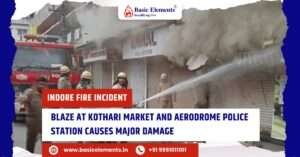Safeguarding Lives: Navigating Fire Safety Compliances in Hazardous Industries
At the core of every industrial setting, there’s a silent guardian – a dedication to fire safety. Delving into the complex realm of hazardous industries, it becomes crucial to adhere to strict fire safety regulations. This blog intends to highlight the significance of fire safety in such settings and delve into the steps that industries should take to safeguard lives and assets.
Why Fire Safety Matters:
Imagine this: a complex web of machinery, Hazardous,chemicals, and processes – a symphony of productivity. In the midst of it all, a spark can set off a disastrous chain of events. Fire safety in hazardous industries is more than just a box to check; it’s a lifeline, a shield against the unpredictable.
Regulatory Framework: Safeguarding Safety
In the complex world of fire safety, industries depend on a strong regulatory framework. National and international standards, along with guidance from organizations like OSHA, show the way. Comprehending and following these rules isn’t just a legal duty; it’s a pledge to establish a safe environment.
Spotting Hazards: Understanding the Threat
In these industries, fire hazards come in different forms. From chemical reactions in manufacturing to the unpredictable nature of oil and gas, and the intricate dance of electricity in electronic industries, the potential risks are many. Recognising these hazards is the first step in creating a defence against fire disasters.
Keeping Things Safe: Designing for Safety
Prevention is key when it comes to fire safety. Design choices, like adequate spacing, ventilation, and using fire-resistant materials, are the first line of defense. Advanced detection and suppression systems act as vigilant guardians, ready to spring into action at the first sign of danger.
Managing Risks and Keeping Safe:
- Carry out a thorough risk assessment to spot possible fire hazards in the industrial facility.
- Put in place practical strategies to lower the risk of fire incidents, like handling flammable materials correctly, using fire-resistant barriers, and keeping equipment well-maintained.
Fire Detection and Early Warning Systems:
- Fit cutting-edge fire detection systems, like smoke detectors, heat sensors, and flame detectors, in strategic locations throughout the facility.
- Set up an early warning system to swiftly alert staff in case of a fire, enabling rapid response and evacuation if needed.
Fire Suppression Systems:
- Make sure you’ve got the right fire suppression systems in place for the specific hazards in your industry, like sprinklers, foam systems, or gas-based suppression.
- Keep a close eye on and maintain these systems to make sure they’ll work if there’s an emergency.
Emergency Response Planning:
- Put together and keep up-to-date a solid emergency response plan with specific steps for dealing with fires.
- Run regular drills and training to get everyone familiar with emergency procedures, evacuation routes, and how to use firefighting equipment.
Employee Training and Awareness:
- Give all your employees thorough training on fire safety, including how to handle hazardous materials, use firefighting gear, and evacuate.
- Encourage a culture of awareness and responsibility among your employees, so they’ll report potential fire hazards, follow safety rules, and help keep the workplace safe.
Employee Training: The Human Firewall
When things get tough, the human factor becomes crucial. Training and awareness programs empower employees to be the first line of defense. Evacuation procedures, emergency response teams, and regular drills are the tools that turn employees into a resilient human firewall.
Case Studies: Learning from Experience
Real-life examples are great teachers. Reviewing past incidents, understanding what worked well, and learning from mistakes provide valuable insights. These case studies are more than just stories; they are lessons that shape the evolution of fire safety.
India has seen several fire accidents over the years. Here’s an overview:
- Cracker factory, Warangal- July 2018
- Sivakasi Firework Factory- April 2012
- Arpit Hotel Fire- December 2019
- Takshashila Centre, Surat- May 2019
- Factory Building in Anaj Mandi area- August 2019
Emerging Technologies: The Future Unveiled
As technology advances, so does our ability to protect against fire threats. Artificial intelligence in fire detection and IoT-based monitoring systems are paving the way for a safer tomorrow. Embracing these innovations ensures that industries stay ahead of the curve in fire safety.
Challenges and Solutions: A Continuous Journey
Implementing fire safety measures comes with its challenges. From financial constraints to logistical complexities, industries face hurdles. However, innovative solutions are available, ready to turn challenges into stepping stones towards a safer future.
Conclusion: A Collective Responsibility
In conclusion, fire safety compliance in hazardous industries is not just about following rules; it’s a collective responsibility to protect lives and livelihoods. As we navigate this complex landscape, let’s remember that the commitment to fire safety is a commitment to a future where industries thrive without compromising the safety of those who make it all possible.
We at Basic Elements are at the forefront of management solutions in Hazardou
For More Information visit : LinkedI






